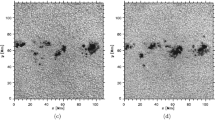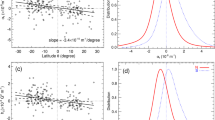Abstract
We study the twist properties of photospheric magnetic fields in solar active regions using magnetographic data on 422 active regions obtained at the Huairou Solar Observing Station in 1988–1997. We calculate the mean twist (force-free field αf) of the active regions and compare it with the mean current-helicity density of these same active regions, h c =B ∥·(∇×B)∥. The latitude and longitude distributions and time dependence of these quantities is analyzed. These parameters represent two different tracers of the α effect in dynamo theory, so we might expect them to possess similar properties. However, apart from differences in their definitions, they also display differences associated with the technique used to recalculate the magnetographic data and with their different physical meanings. The distributions of the mean αf and h c both show hemispherical asymmetry—negative (positive) values in the northern (southern) hemisphere—although this tendency is stronger for h c. One reason for these differences may be the averaging procedure, when twists of opposite sign in regions with weak fields make a small contribution to the mean current-helicity density. Such transequatorial regularity is in agreement with the expectations of dynamo theory. In some active regions, the average αf and h c do not obey this transequatorial rule. As a whole, the mean twist of the magnetic fields αf of active regions does not vary significantly with the solar cycle. Active regions that do not follow the general behavior for αf do not show any appreciable tendency to cluster at certain longitudes, in contrast to results for h c noted in previous studies. We analyze similarities and differences in the distributions of these two quantities. We conclude that using only one of these tracers, such as αf, to search for signatures of the α effect can have disadvantages, which should be taken into account in future studies.
Similar content being viewed by others
References
N. Seehafer, Sol. Phys. 125, 219 (1990).
A. A. Pevtsov, R. C. Canfield, and T. R. Metchalf, Astrophys. J. Lett. 440, L109 (1995).
V. I. Abramenko, T. J. Wang, and V. B. Yurchishin, Sol. Phys. 168, 75 (1996).
S. D. Bao and H. Q. Zhang, Astrophys. J. 496, L43 (1998).
K. M. Kuzanyan, H. Zhang, and S. Bao, Sol. Phys. 191, 231 (2000).
R. C. Canfield and A. A. Pevtsov, in Synoptic Solar Physics, Ed. by K. S. Balasubramaniamn, J. W. Harvey, and D. M. Rabin, ASP Conf. Ser. 140, 131 (1998).
H. Zhang and S. Bao, Astrophys. J. 519, 876 (1999).
G. E. Hale, Nature 119, 708 (1927).
R. S. Richardson, Astrophys. J. 93, 24 (1941).
S. F. Martin, R. Bilimoria, and P. W. Tracada, in Solar Surface Magnetism, Eds. C. J. Rutten and C. J. Schrijver (Kluwer, Dordrecht, 1994), p. 303.
D. M. Rust and A. Kumar, Astrophys. J. Lett. 464, L199 (1996).
F. Krause and K. H. Rädler, Mean-Field Magnetohydrodynamics and Dynamo Theory (Akademie-Verlag, Berlin, 1980).
F. Krause, Habilitationsschrift (Univ. Jena, 1967); The Turbulent Dynamo, NCAR Technical Note TN/IA-60 (1971).
A. Brandenburg and K. J. Donner, Mon. Not. R. Astron. Soc. 288, L29 (1997).
A. Brandenburg, S. H. Saar, and C. R. Turpin, Astrophys. J. Lett. 498, L51 (1998).
R. K. Keinigs, Phys. Fluids 26, 2558 (1983).
N. Seehafer, Europhys. Lett. 27, 353 (1994).
N. Seehafer, in New Perspectives on Solar Prominences (IAU Coll. 167), Eds. D. Webb, D. Rust, and B. Schmieder, ASP Conf. Ser. 150, 407 (1998).
D. W. Longcope, G. H. Fisher, and A. A. Pevtsov, Astrophys. J. 507, 417 (1998).
L. Woltjer, Proc. Nat. Acad. Sci. 44, 489 (1958).
T. J. Wang, A. A. Xu, and H. Q. Zhang, Sol. Phys. 155, 99 (1994).
J. B. Zirker, S. F. Martin, K. Harvey, and V. Gaizauskas, Sol. Phys. 175, 27 (1997).
H. Zhang and S. Bao, Astron. Astrophys. 339, 880 (1998).
H. Q. Zhang, G. Ai, T. Sakurai, and H. Kurokawa, Sol. Phys. 136, 269 (1991).
H. Q. Zhang, Sol. Phys. 154, 207 (1994).
S. D. Bao, A. A. Pevtsov, T. J. Wang, and H. Q. Zhang, Sol. Phys. 195, 75 (2000).
E. N. Parker, Astrophys. J. 122, 293 (1955).
H. Yoshimura, Astrophys. J. 247, 1102 (1981).
N. H. Brummell, N. E. Hurlburt, and J. Toomre, Astrophys. J. 493, 955 (1998).
J. Schou, H. M. Antia, S. Basu, et al., Astrophys. J. 505, 390 (1998).
Author information
Authors and Affiliations
Additional information
__________
Translated from Astronomicheski\(\overset{\lower0.5em\hbox{$\smash{\scriptscriptstyle\smile}$}}{l} \) Zhurnal, Vol. 79, No. 5, 2002, pp. 469–480.
Original Russian Text Copyright © 2002 by Zhang, Bao, Kuzanyan.
Rights and permissions
About this article
Cite this article
Zhang, H., Bao, S. & Kuzanyan, K.M. Twist of magnetic fields in solar active regions. Astron. Rep. 46, 424–434 (2002). https://doi.org/10.1134/1.1479429
Received:
Accepted:
Issue Date:
DOI: https://doi.org/10.1134/1.1479429




